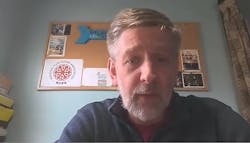The evolution of how power is generated and controlled has opened new vistas of innovation and new possibilities for the effective and efficient use of energy. Business leaders are planning for an electrified future that reduces carbon emissions—but they have to build that future with the existing technology in order to realize that goal.
At the intersection of all of this is the fluid power industry. The power factor of hydraulics and the precision of pneumatics have evolved over time to more hybrid approaches that include electrification—yet the value propositions that propelled each technology in the past remain valid for the next generation of systems. The future of off-highway construction will be impacted by a coming acceleration of electric vehicles that reduce emissions and maintenance and provide for autonomous operation.
And overlaying all of this is the proliferation of available data on system performance, fuel optimization and machine health. The use of sensors and analytics to identify what is happening in plants across the world has increased, and that data has opened new windows into ways to improve every aspect of a system.
In Power & Motion’s discussion with a wide range of industry leaders on these topics, the new power sources, the new control functions and an emphasis on clean fuels and environmentally sound practices won’t displace the traditional fluid power technology any time soon.
In other words, two things are clear:
- Everything is changing in the fluid power industry, and
- Nothing is changing in the fluid power industry.
High on Hydraulics
Hydraulics have been the focal point for much of the industry changes. An area of particular growth has been electric off-highway vehicles for use on construction and agriculture. At the recent CES Show in Las Vegas, Doosan Bobcat unveiled an all-electric compact track loader. At the same show, John Deere unveiled its autonomous tractor, ready for large-scale production.
While all of this was going on, Danfoss Power Solutions made a major investment in hydraulics, purchasing Eaton’s hydraulics business for $3.3 billion at the start of 2021. Danfoss Power Solutions President and CEO Eric Alstrom said that move will be enhanced by electrification, but that hydraulics remains a critical power source for the future.
“Hydraulics is strategic for us. It is our core, and we believe in it,” Alstrom told Power & Motion. “Electrification is coming, no doubt. But there are a lot of applications where energy density and power density simply favor hydraulics, and that why we remain in the favor for hydraulics for many, many years to come.
“When there is a substitution impact for effect with electrification, you'll still need implements that are hydraulic,” Alstrom added. “A lot of the work functions, machines and so on still will remain hydraulic.”
The National Fluid Power Association has been studying the impact of electrification on the industry—and its members. One of the key conclusions, according to NFPA president and CEO Eric Lanke, is that electrification is hardly a new concept for the industry.
“Remember that in most of the industrial applications of fluid power, the prime mover is already an electric motor. So, the interface between electric power and a hydraulic [system], or especially a pneumatic system, is pretty well understood,” Lanke said. “The challenge is—and the innovation is coming—when you try to put that in a contained envelope that exists on a piece of mobile equipment.
“And this is something that we see our mobile customers really driving. They’re seeking better efficiency. They’re seeking lower emissions,” Lanke added. “And so, we have to find new ways of making sure that hydraulics hybridizes and connects with that electric power source to continue to provide the strength and the power that you need.”
“I think you’re going to see the continuing trend towards electrification. I think it’s pretty much a realization at this point because in certain applications, you can probably do it more efficiently and more sustainably with electric, and it might be easier to implement it,” said Thomas Wanke, director of the Fluid Power Industrial Consortium, who also leads industry relations at Milwaukee School of Engineering. “But you know, there are applications where there are holes. I think it’s going to be fluid power, especially where you have high power density—although every time you look at a newer breed of electromechanical actuators, they seem to be getting bigger and stronger and more powerful.” Wanke also is a member of the Power & Motion Editorial Advisory Board
“I think what’s driving most of this…we separate out electrification from what’s going on in the light duty passenger market to what’s going on in heavy duty off highway construction and agriculture,” said Mike Terzo, founder and CEO of Terzo Power Systems and a member of the Power & Motion Editorial Advisory Board. “There is electrification based on productivity, TCO (total cost of ownership), performance, maintenance. Those are the drivers on connectivity that are bringing actual value to different stakeholders. So, it’s a different set of value drivers than we see in the light duty market.”
“We think we can play a large role because the hydraulics are going to be a necessary actuation technology, regardless of the how the vehicles are propelled,” Lanke added. “So, we’re watching that closely, but we think that’s going to be a net positive for the association and for the industry.”
Designs on the Future
A number of companies have invested in technology and applications solutions to meet the industry changes. That emphasis on innovation has been important. It’s also been invigorating.
“It has engineers and designers really excited to be trying new things that work—applying strengths of electrification and strengths of hydraulics to come up with really clever machine designs,” said Paul Carlson, CEO of Tolomatic and a member of the Power & Motion Editorial Advisory Board. “I think a lot of it was motivated during this pandemic period when people were forced to do things better and faster and the demand for certain things in the industrial space. And having been in a number of those factories, you can actually put your hands on these hybrid solutions and watch the complex motion and control in these factories.”
Out of this, Carlson said, has come a hybrid solution to product development as well as to products themselves. “They aren't dedicated to one science anymore. It isn't just, ‘Sorry we’re a hydraulic house,’ or ‘Sorry, we just do things pneumatically,’” Carlson said. “‘We welcome all [solutions]’ is the answer I'm seeing from these really bright engineers.”
As with most innovation, there are multiple sources engaged in the process. “We pride ourselves on being applications experts, so not just knowing the products or the components in the system, but actually going beyond that,” said Alstrom. “And many times, we reach out to our own customers, end-users, and bring them in for clinics and workshops. Maybe it’s a little bit audacious to say that we’re almost as good as our OEMs and understanding the end customer, but it has become a strength of ours.”
There’s also a sense that opening up those lines of communications allow for a closer relationship between suppliers and end users. “We’ve changed our messaging a bit in the last 12 months from, ‘Come see us here at Tolomatic for a hydraulic replacement.’ We don't really use that language anymore,” said Carlson. “It’s really, ‘Come talk to us about your application where the strengths of electric might complement the strengths of an air- or hydraulic-based machine.’ And it's really been an effective message.”
A New Future for Pneumatics
The pneumatics market is challenged with the expanding use of electric solutions for actuation and motion control, particularly in electric vehicles. Even here, however, there is no single solution.
“That’s an area where there’s a lot of linear actuators being utilized right now, and it’s anything from a simple single axis all the way up to more complex multi-axis systems and working together as they go and then on the other end, the assembly of the vehicles themselves,” said Richard Vaughn, automation engineering manager at Bosch Rexroth. “The trend there on the EVs is they’re being utilized a lot upfront, more so than I’ve ever seen them in the automotive industry.”
Vaughn said he’s noticed the combination of pneumatics and electric actuation has led to utilizing benefits for both solutions. “It was “bang, bang” with pneumatics. Now at the end of travel, you can change the stroke a little bit,” Vaughn told Power & Motion. “I’ve got several customers that are actually doing that to save the parts on the end. Now, at the end of the motion, you’re still getting the same cycle time, but that last five millimeters is a lot slower. You just can’t see it.
“It used to be just two positions that you could get out of pneumatics and now [you’re] able to do multiple positions,” Vaughn added. “But then the precision and what you need now with the with the electric coming into play, we’re seeing the electric actually evolving into larger sizes than we’ve ever seen before—being able to do that motion and actually optimize it. And that’s one of the things, at least with the servo-driven.”
I think you’re going to see the continuing trend towards electrification,” Wanke said. “I think it's pretty much a realization at this point because in certain applications, you can probably do it more efficiently and more sustainably with electric, and it might be easier to implement it.”
“Room for Everybody”
The passage of the U.S. infrastructure bill points the technology toward a cleaner and more efficient transportation and communications system for the future. For now, the construction of roads, bridges and a new electric grid to handle the power and data will largely be accomplished by the traditional earth moving equipment. But the times are changing, and the change is rapid.
What we learned during the pandemic, especially now with significantly increasing supply chain costs, is that it makes perfect sense both for our flexibility but also from a cost perspective to be more local,” Alstrom told Power & Motion. “So, from that perspective, this infrastructure bill, at least for our suppliers, will be extremely beneficial because we now have localized the bulk of our supply in the U.S.”
Lanke agrees, noting the new technology will require new workers with new job descriptions to toil along with the fluid power engineer. There's no doubt we need more data scientists and we need more electrical engineers, to kind of help the industry through some of those challenges,” Lanke said. “A lot of players in our membership have already adapted well and are delivering effective IoT-based products into the supply chain. But I think there’s a lot of extra advantage that can come with even more development in that space.
“We have a hashtag that we use on social media: #onlyfluidpowercan. And that’s what we used to call attention to where you can find fluid power in the marketplace to weigh in positive and exciting things,” Lanke said. “We’re going to see a lot of new spending on vehicles, on machines and on the fluid power that drives them in order to make all those projects come to fruition. So, I think from a from a business growth perspective, it’s a net positive for that for our industry.”
As it has been for the bulk of the U.S. economy, finding those workers requires the kind of recruiting usually reserved only for point guards and quarterbacks. “We are hard at work in all the communities where we are, of course, working closely with the communities, but also try to make people enthusiastic about a manufacturing job,” Alstrom said. “And that also means that we as an employer need to be better than we were in the past for taking care of the people. And it's not just wages, but it’s also doing things for the community, doing things for the families in the community and being close to the issues in the community, frankly. And wherever we do work now, we're doing that.”
The industry those workers come into will have change as its only constant. And in that change, Terzo notes, there won’t be one dominant solution, but the right solution, tailored to the specific application. “The reality is that it’s not going to be one or the other. I think fluid power will lose some ground in some applications,” he said, “but it's actually going to gain ground in others because we actually can now—per a given cost point—we can actually now grab some hydraulic ground back from electromechanical. So, it’s interesting; that's why it’s such an exciting time to be in this industry.”
Or as Vaughn noted, “There’s definitely room for everybody.”
In Their Own Words: Fluid Power Leaders Look to the Future
Power & Motion discussed the near-term opportunities and long-term challenges faced by the fluid power industry. Click on the headlines for each to access the video clips.
The Workforce Shortage is About More Than Money
Eric Alstrom, president of Danfoss Power Solutions, said manufacturers have to do more than simply provide a heftier paycheck to attract and retain manufacturing workers. “We are hard at work in all the communities where we are, of course, working closely with the communities, but also try to make people enthusiastic about a manufacturing job,” Alstrom told Power & Motion. “And that also means that we as an employer need to be better than we were in the past for taking care of the people. And it's not just wages, but it's also doing things for the community, doing things for the families in the community and being close to the issues in the community, frankly. And wherever we do work now, we're doing that.”
Eric Lanke, president and CEO of the National Fluid Power Association (NFPA), talked with Power & Motion about the role NFPA already has undertaken in shaping the future uses of fluid power, and how hydraulics will figure in that future. “We think we can play a large role because the hydraulics are going to be a necessary actuation technology regardless of how the vehicles are propelled. So, we’re watching that closely, but we think that’s going to be a net positive for the association and for the industry,” Lanke said.
Richard Vaughn, automation engineering manager at Bosch Rexroth, said the electrification of motion control and actuation will mean an expanded role for pneumatics. “It was ‘bang, bang’ with pneumatics. Now at the end of travel, you can change the stroke a little bit,” Vaughn told Power & Motion. “I’ve got several customers that are actually doing that to save the parts on the end. Now, at the end of the motion, you’re still getting the same cycle time, but that last five millimeters is a lot slower. You just can’t see it. There’s definitely room for everybody.”
Mike Terzo, founder and CEO of Terzo Power Systems, told Power & Motion the relationship between traditional hydraulics and electromechanical systems will be a marriage where each power system brings value to the relationship. “There are things that you can do with hydraulics that you will know maybe never be able to do with electromechanical,” Terzo told Power & Motion. “So, I think there’s there are a lot of people that think like, ‘Oh, all the hydraulics are going to be replaced.” There’s just realities again that aren’t going to allow that to happen.”





